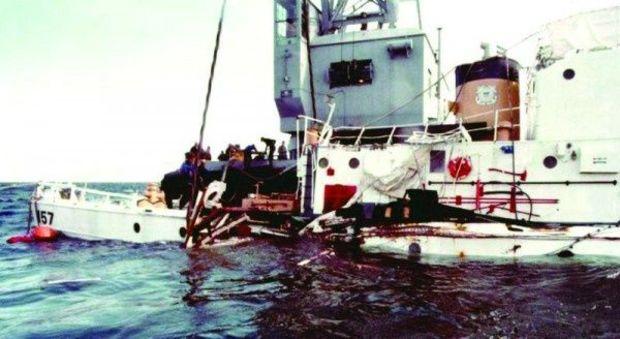The U.S. Coast Guard Cutter Cuyahoga was a 125-foot Active-class patrol boat built in 1927. She sank in October, 1978 following a collision with a freighter in the Chesapeake Bay.

The Active class was comprised of 33 ships with the Cuyahoga to be the last in service; all served in World War II. They were designed for the outer line of patrol during prohibition and quickly gained a reputation for durability.
After her commissioning, the Cuyahoga was at work intercepting rum runners in the Atlantic Ocean. In 1935, she was commissioned in the U.S. Navy to serve as a tender for the presidential yacht, USS Potomac. In May of 1941, the Cuyahoga was recommissioned by the Coast Guard at Washington Navy Yard and later arrived at her permanent new station in Baltimore, MD, before being sent on escort duty during World War II.
From October 1942 to June 1945, the Cuyahoga was at work escorting vessels through the Caribbean Sea. After the war, she was transferred back to Norfolk and then to Curtis Bay, MD. For three years the ship was used to train officer candidates in New London, CT, before returning, once again, to Maryland.
By 1978, the Cuyahoga was the oldest commissioned vessel still in Coast Guard service. On the night of October 20, 1978, Cuyahoga was conducting a training cruise in the Chesapeake Bay near the mouth of the Potomac River. She was under the command of Chief Warrant Officer Donald K. Robinson, a 27-year Coast Guard veteran, and had 29 crew members onboard. The weather was calm and clear that night, but there was no radar in the wheelhouse. Instead, it was in the back of the bridge and as such was not readily accessible to the ship’s commander.
At 8:45 p.m., a light was spotted on the horizon, and it was assumed to belong to a small fishing vessel, about eight miles ahead. In actuality, the light belonged to the 521-foot Argentinian bulk freighter, M/V Santa Cruz II, loaded with 19,000 tons of coal. John Hamill, a seven-year veteran pilot, was piloting the Santa Cruz II that night. He spotted the Cuyahoga but was not yet concerned as the vessel appeared to be preparing to pass the freighter on its port side. But when the two vessels were only 1200 yards apart, the Cuyahoga turned west to enter the Potomac River. She turned right into the path of the Santa Cruz II, still believing that the light belonged to a small fishing vessel.
Hamill sounded the whistle, indicating that he would maintain course and that the cutter should turn right (back to her original course). There was no response from the Cuyahoga. Hamill then sounded a danger warning of five short blasts and still the Cuyahoga maintained her course, not realizing that a freighter was quickly bearing down upon her.
At 9:07 p.m., Santa Cruz II tore through the Cuyahoga’s midship, about 40 feet from the stern, rolling her over at a 50-degree angle. She sank within a matter of minutes in 58 feet of water. The Santa Cruz II quickly turned around after the collision to pick up survivors, but of the 29 crew members aboard the cutter that night, 11 were lost at sea.
A U.S.C.G. inquiry later exonerated Hamill, the pilot of Santa Cruz II, of any wrongdoing. Robinson, the commander of the Cuyahoga, was found guilty of dereliction of duty by a court martial jury in November 1979. On October 29, 1978, just nine days after the sinking, the Cuyahoga was raised and brought to Portsmouth, VA, to be patched. On March 29, 1979, she was towed 15 miles offshore of the Virginia Capes and scuttled as an artificial reef, where she remains to this day.